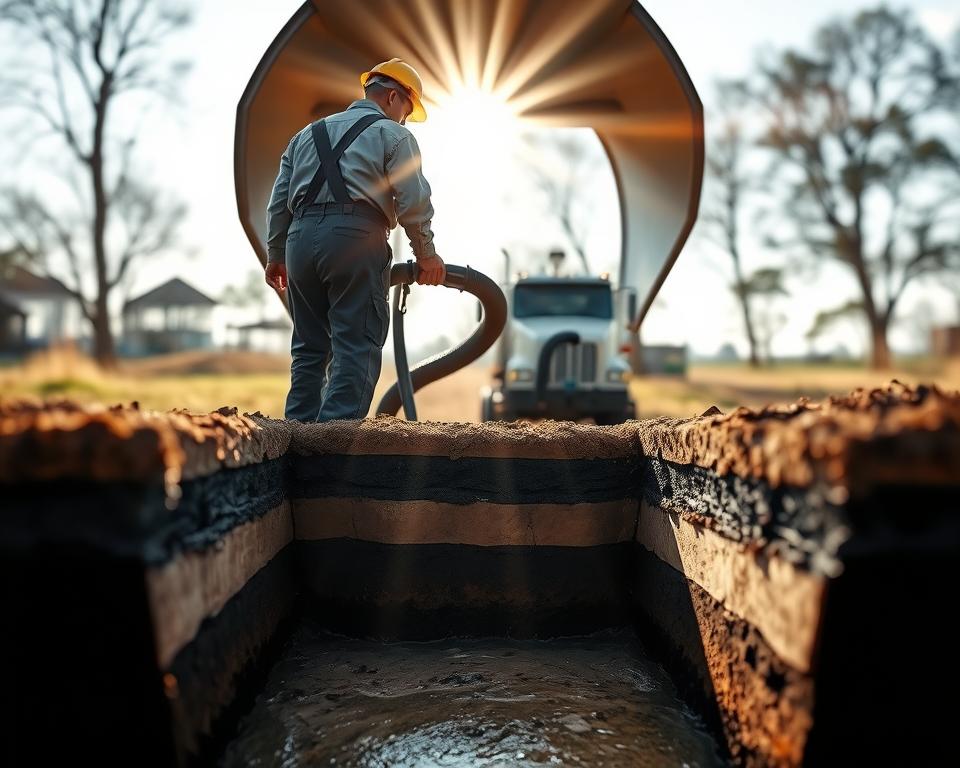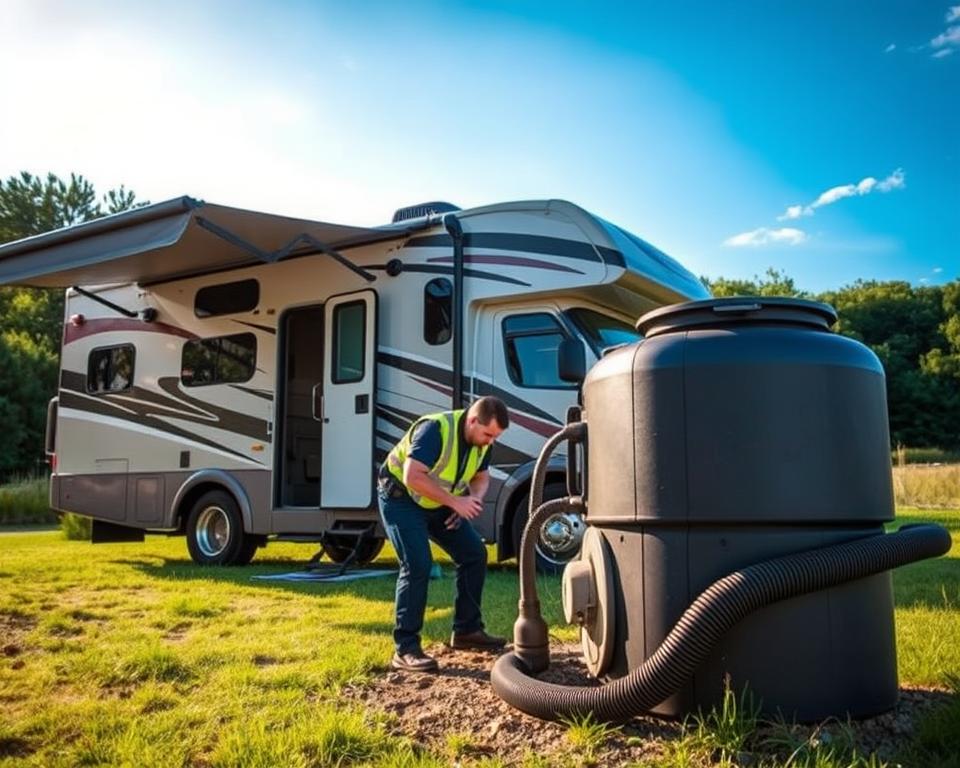Septic Aerator Unit: Essential Guide for Property Owners
Ever pondered on what drives your oxygen-based Septic system’s effectiveness? The Septic air pump is the unrecognized workhorse indispensable for your system. Through this guide, property owners will get practical insight on the air Pump’s purpose. It’s critical for a healthy, efficient Septic tank.
Appreciating the necessity of a Septic tank air Pump can improve your Septic system’s capabilities using septic tank inspection cost. It also preserves your property’s value and local environment. This guide will feature All in Sanitation, a well-regarded Septic industry authority. They’re ready to meet your Septic aerator Pump requirements.
Key Takeaways
- The Septic air Pump is crucial for aerobic Septic systems.
- Looking after your Septic system air Pump can optimize overall system operation.
- Periodic reviews lengthen the service life of your Septic tank air Pump.
- Selecting the correct Septic aerator Pump is key for peak operation.
- All in Sanitation supplies dedicated services for Septic air Pump needs.
Understanding Aerobic Septic Systems
Aerobic Septic systems provide a more effective waste treatment approach by employing oxygen. This technique employs aerobic bacteria living in well-oxygenated environments. These bacteria are better in decomposing organic matter. With the help of Septic aerator Pumps, these systems ensure a consistent oxygen supply, improving the waste decomposition process.
These systems perform well in reducing sludge buildup, owing to the activity of aerobic bacteria. This drop in solid waste means less maintenance and Pumping is required. Additionally, they successfully handle wastewater, producing little to no smell. This produces a improved environment for homeowners and the community overall.
To guarantee these systems work efficiently, it’s essential to understand the key Septic system components. These include the Septic tank, treatment chamber, and effluent Pump. Each component has a crucial role, especially the air Pump. It injects oxygen into the tank, essential for the aerobic bacteria’s performance.
Significance of the Septic Air Pump
The Septic air Pump is key in the operation of aerobic Septic systems. It serves as the system’s “lungs,” delivering the needed oxygen required. This oxygen allows aerobic bacteria to thrive and decompose waste properly. If the Pump malfunctions, the system’s effectiveness diminishes, resulting in sludge buildup and possible odors.
Such issues can undermine Septic system operations and lead to environmental hazards. By realizing how essential the Septic air Pump is, homeowners can respond ahead of time. They can secure its best function through scheduled service. This wards off failures, avoids costly repairs, and maintains the aerobic system’s integrity.
Primary Gains of Using a Septic Air Pump
Employing a Septic air Pump markedly increases the capability of Septic systems. Septic air Pumps are vital as they speed up the breakdown of waste. This is realized by oxygenating the treatment process, supporting aerobic bacteria growth. These bacteria are necessary for successful waste treatment.
They’re also useful in lowering foul smells. Because of more active aerobic processes, waste is processed faster, thus lessening odors. This creates a nicer atmosphere for homeowners.
Another valuable benefit is the decrease in sludge formation. Consequently, tanks demand less frequent Pumping, saving both money and time. Improved processing not only reduces spending but also lengthens the lifespan of the drain field.
Maintaining these Pumps diligently means less frequent repair costs and meeting regulatory standards. Thus, the pluses of Septic air Pumps extend past for homeowners. They also benefit environmental health by raising waste management practices.
| Benefit | Description |
|---|---|
| Fast Waste Breakdown | Increased aerobic activity hastens the decomposition process. |
| Minimized Odor Emissions | Superior treatment efficacy results in fewer odors. |
| Reduced Sludge Buildup | Fewer Pumping and maintenance are necessary. |
| Extended Drain Field Life | Better treatment ensures a healthier drain field. |
| Cost Savings | Lower risk of repairs and regulatory compliance cost. |

Choosing the Right Septic Air Pump
Opting for the right Septic air Pump is key for an efficient aerobic system. Homeowners ought to review various factors for the perfect selection. The dimensions of the tank and the airflow requirements are important the Pump’s performance.
To decide wisely, it’s helpful to understand the air Pumps available. There are mainly two types: linear diaphragm Pumps and rotary vane Pumps. Each offers unique benefits, which should be aligned with your home’s unique requirements and daily load.
Energy use also deserves attention. Picking a Pump that minimizes energy use while achieving the needed airflow can offer significant savings. Help from All in Sanitation professionals can be invaluable. They verify the Pump you choose fits your system’s requirements perfectly.
Typical Classes of Septic Air Pumps
Homeowners can make better choices by recognizing the distinct Septic air Pumps available. There are mainly two types: diaphragm Pumps and rotary vane Pumps. Each has its specific functions and benefits.
Diaphragm Pumps, valued for their quiet operation, are favored for residential Septic systems. They deliver energy efficiency while supplying consistent airflow. Their constant performance matches smaller systems, preferred by many homeowners.
Rotary vane Pumps, however, are ideal for higher-capacity or commercial systems. These Pumps provide more power, essential in handling bigger loads. Their robust build guarantees efficient operation in broad Septic systems.
| Type of Pump | Best Use | Advantages |
|---|---|---|
| Diaphragm Pumps | Residential Systems | Quiet operation, energy-efficient, reliable air flow |
| Rotary Vane Pumps | Larger or Commercial Systems | Powerful performance, high capacity, durable construction |
Knowing the contrasts in Septic air Pumps is important for upgrades or replacements. Each Pump type provides particular attributes to satisfy various needs. This provides optimal performance for any system.
How to Tell You Need a Septic Air Pump Replacement
Homeowners must watch for Pump failure signs in their Septic systems. Some symptoms point towards the need for a Septic air Pump replacement. These help maintain smooth operation. Catching these in time avoids bigger issues.
Signs of potential problems include:
- Unusual noises from the Pump, like scraping or buzzing, might show internal damage.
- A clear lack of air output indicates the Pump isn’t working well, impacting efficiency.
- Ongoing electrical problems, such as circuit trips or flickering lights, could indicate overloading.
- Visible damage on the Pump unit, with cracks or leaks, demands quick action.
- Unpleasant odors in the yard often reveal a compromised Pump, meaning ineffective effluent aeration.
Finding these signs early stops high repair bills or total system failure. Scheduling consistent assessments assists in finding these issues. It also clarifies if you need a new Septic air Pump.
Maintenance Tips for Your Septic Air Pump
For an optimal Septic air Pump, periodic care is crucial. This ensures that that your system functions properly. Homeowners can employ several practical care strategies for peak results.
Bi-annually, perform a detailed inspection for wear or damage. It is also essential to replace the filters as recommended. This stops clogs that could lower efficiency.
The Pump should stand on a steady base to minimize vibrations, which could wear it over time. A protective cover is vital too. It guards against debris and water, keeping the Pump’s functionality.
Regular servicing can considerably increase the life of your Pump. In turn, this enhances the Septic system’s performance collectively.
| Maintenance Task | Frequency | Benefits |
|---|---|---|
| Inspect Pump for damage | Every 6 months | Catches problems quickly |
| Replace filters | As needed | Keeps performance up |
| Check surface stability | Annually | Reduces vibrations |
| Clear debris around Pump | Monthly | Avoids obstruction |
Placing Your Septic Air Pump
Accurate installation of your Septic air Pump is essential for its optimal operation. First, select a safe, moisture-free area for placement. The chosen spot should securely support the Pump’s weight without issue.
To successfully fit your Pump on your own, use the following guidelines:
- Assemble all necessary items, including the Pump, a power source, and hose fittings.
- Carefully read the manufacturer’s guidelines before starting your installation.
- Verify every connection is proper to eliminate air leaks that hurt performance.
- After assembly, run a test to verify the system works as intended.
If the installation process looks challenging, reach out to All in Sanitation. Their professionals can prevent common errors, making sure your setup follows relevant safety requirements.
Advantages of Using All in Sanitation for Your Septic Air Pump Services
When deciding on a Septic service provider, the choice is important. All in Sanitation distinguishes itself by delivering dependable Septic air Pumps. They address varied homeowner requirements with a extensive selection of top-tier products. This guarantees customers find an ideal match for their Septic systems.
What clearly distinguishes All in Sanitation is beyond their broad product lineup. Their focus to superior customer service is also critical. Homeowners enjoy knowledgeable support, leading them to trusted Septic solutions. This teamwork is crucial to customize each solution to satisfy specific needs.
All in Sanitation also focuses on aftercare to ensure lasting satisfaction. Their devotion extends beyond the initial sale. They offer ongoing support to keep Septic systems running smoothly for the foreseeable future.
Financial Aspects for Septic Air Pumps
Grasping the costs linked to Septic air Pumps is essential for homeowners using aerobic Septic systems. Initially, one faces the initial cost, which includes the Pump and associated accessories. Installation expenses vary, depending on the system’s complexity and any modifications required.
Ongoing upkeep forms an additional cost layer. Regular inspections can head off bigger issues, eventually resulting in savings. Homeowners should set aside funds for Septic maintenance to preserve the Pump’s effectiveness and service life. Such planning helps dodge expensive repairs later on, illustrating the value of proactive maintenance.
| Cost Component | Average Cost Range |
|---|---|
| Septic Air Pump | $500 – $1,200 |
| Installation | $300 – $800 |
| Annual Maintenance | $150 – $400 |
| Potential Repair Costs | $1,000 – $5,000 |
Breaking down Septic air Pump expenses into distinct parts assists homeowners in cost forecasting. This thorough approach secures the system’s reliable running and their confidence.
In Closing
For homeowners with aerobic Septic systems, maintaining Septic units is key. The right Septic air Pump boosts waste processing and increases your system’s life. Committing to ongoing care and swiftly handling issues stops costly fixes and disruptions.
Choosing a Septic air Pump warrants consideration. This guide highlighted how to select effectively about installation and replacement. With All in Sanitation’s guidance, you can tackle your Septic systems’ complexities with confidence.
Maintaining your Septic air Pump improves your system’s functionality and longevity. It ensures a reliable and successful operation over time. Keep in mind, your home’s wastewater management relies heavily on consistent upkeep.


